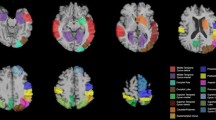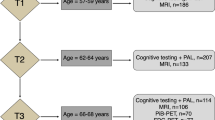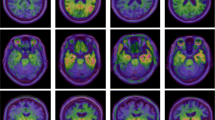Abstract
The case of a 64-year-old woman affected by slowly progressive visual agnosia is reported aiming to describe specific cognitive-brain relationships. Longitudinal clinical and neuropsychological assessment, combined with magnetic resonance imaging (MRI), spectroscopy, and positron emission tomography (PET) were used. Sequential neuropsychological evaluations performed during a period of 9 years since disease onset showed the appearance of apperceptive and associative visual agnosia, alexia without agraphia, agraphia, finger agnosia, and prosopoagnosia, but excluded dementia. MRI showed moderate diffuse cortical atrophy, with predominant atrophy in the left posterior cortical areas (temporal, parietal, and lateral occipital cortical gyri). 18FDG-PET showed marked bilateral posterior cortical hypometabolism; proton magnetic resonance spectroscopic imaging disclosed severe focal N-acetyl-aspartate depletion in the left temporoparietal and lateral occipital cortical areas. In conclusion, selective metabolic alterations and neuronal loss in the left temporoparietooccipital cortex may determine progressive visual agnosia in the absence of dementia.



Similar content being viewed by others
References
Lissauer H (1890) Ein fall von seelenblindhelt nebst einen beitrag zur theorie derselben. Arch Psychiatr 27:222–270
Warrington EK, James M (1986) Visual object recognition in patients with right hemisphere lesion: axes or features? Perception 15:355–356
Warrington EK, James M (1988) Visual apperceptive agnosia: a clinico-anatomical study of three cases. Cortex 24:13–32
Warrington EK (1975) The selective impairment of semantic memory. Q J Exp Psychol 27:635–657
Davidoff J, Wilson B (1985) A case of visual agnosia showing a disorder of pre-semantic visual classification. Cortex 21:121–134
Feinberg TE, Schindler RJ, Ochoa E, Kwan PC, Farah JM (1994) Associative visual agnosia and alexia without prosopoagnosia. Cortex 30:395–412
De Renzi E, Lucchelli F (1993) The fuzzy boundaries of apperceptive agnosia. Cortex 29:187–215
Benson DF, Davis RJ, Snyder BD (1988) Posterior cortical atrophy. Arch Neurol 45:789–793
Sartori G, Job R, Miozzo M, Zago S, Marchiori G (1993) Category-specific form-knowledge in a patient with herpes simplex virus encephalitis. Neuropsychologia 2:280–299
Benson DF, Greenberg J (1969) Visual form agnosia. Arch Neurol 20:82–89
Hécaen H, Albert M (1978) Human neuropsychology. Wiley, New York
Tang-Wai D, Mapstone M (2006) What are we seeing? Is posterior cortical atrophy just Alzheimer’s disease? Neurology 66:300–301
Mesulam MM (1982) Slowly progressive aphasia without generalised dementia. Ann Neurol 11:592–598
De Renzi E (1986) Slowly progressive visual agnosia or apraxia without dementia. Cortex 22:171–180
Della Sala S, Spinnler H, Trivelli C (1996) Slowly progressive impairment of spatial exploration and visual perception. Neurocase 2:299–323
Crystal HA, Horoupian DS, Katzman R, Jotkowitz S (1992) Biopsy-proved Alzheimer disease presenting as a right parietal lobe syndrome. Ann Neurol 12:186–188
Rosenfeld M (1909) Die Partielle Grosshirnatrophie. J Psychol Neurol 14:115–130
Tang-Wai DF, Graff-Radford NR, Boeve BF et al (2004) Clinical, genetic, and neuropathological characteristics of posterior cortical atrophy. Neurology 63:1168–1174
Kirshner HS, Lavin PJM (2006) Posterior cortical atrophy: a brief review. Curr Neurol Neurosci Rep 6:477–480
Luzzatti C, Willmes K, De Bleser R (1991) Aachener Aphasie Test. Versione italiana. Organizzazioni Speciali, Florence
Spinnler H, Tognoni G (1987) Standardizzazione e taratura italiana di test neuropsicologici. Ital J Neurol Sci 6(Suppl 8):1–120
Basso A, Capitani E, Laiacona M (1987) Raven’s coloured progressive matrices: normative data on 305 adult normal controls. Funct Neurol 2:189–194
Weigl E (1927) On the psychology of so-called processes of abstraction. J Abnorm Soc Psychol 36:3–33
Novelli G, Papagno C, Capitani E, Laiacona M, Vallar G, Cappa SF (1986) Tre test clinici di ricerca e produzione lessicale. Taratura su soggetti normali. Arch Psicol Neurol Psichiatr 47:447–506
De Renzi E, Pieczuro E, Vignolo LA (1966) Oral apraxia and aphasia. Cortex 2:50–73
De Renzi E, Motti F, Nichelli P (1980) Imitating gestures. A quantitative approach to ideomotor apraxia. Arch Neurol 37:6–10
Arrigoni C, De Renzi E (1964) Constructional apraxia and hemispheric locus of lesion. Cortex 1:170–197
Lezak M (1995) Neuropsychological assessment. Oxford University Press, New York
Novelli G, Papagno C, Capitani E, Laiacona M, Cappa SF, Vallar G (1986) Tre test clinici di memoria verbale a lungo termine. Taratura su soggetti normali. Arch Psicol Neurol Psichiatr 47:278–296
Riddoch MJ, Humphreys GW (1993) BORB: Birmingham Object Recognition Battery. Lawrence Erlbaum Associates, Hove
Benton AL, Varney NR, Hamsher K de S (1990) Test di orientamento di linee. Organizzazioni Speciali, Florence
Benton AL, Hamsher K de S, Varney NR, Spreen O (1993) Test di riconoscimento di volti ignoti. Organizzazioni Speciali, Florence
Trojano L, Grossi D (1992) Impaired drawing from memory in a visual agnosic patients. Brain Cogn 20:327–344
Riddoch MJ, Humpreys GW, Gannon T, Blott W, Jones V (1999) Memories are made of this: the effects of time on stored visual knowledge in a case of visual agnosia. Brain 122:537–559
Wilson BA, Davidoff J (1993) Partial recovery from visual object agnosia: a 10-year follow-up study. Cortex 29:529–542
Magnani G, Bettoni L, Mazzucchi A (1982) Lesioni atrofiche bioccipitali di incerta natura all’origine di una agnosia visiva. Riv Neurol 52:137–148
Mizuno M, Sartori G, Liccione D, Battelli L, Campo R (1996) Progressive visual agnosia with posterior cortical atrophy. Clin Neurol Neurosurg 98:176–178
Grunthal E (1926) Uber die Alzheimersche Krankheit: eine histopathologisch-klinische Studie. Z Ges Neurol Psychiatry 101:128–157
Wakai M, Honda H, Takahashi A, Kato T, Ito K, Hamanaka T (1994) Unusual findings on PET study of a patient with posterior cortical atrophy. Acta Neurol Scand 89:458–461
Attig E, Jacquy J, Uytdenhoef P, Roland H (1993) Progressive focal degenerative disease of the posterior associative cortex. Can J Neurol Sci 20:154–157
McMonagle P, Deering F, Berliner Y, Kertesz A (2006) The cognitive profile of posterior cortical atrophy. Neurology 66:331–338
Mendez MF, Tomsak RL, Remler B (1990) Disorders of the visual system in Alzheimer’s disease. J Clin Neuroophthalmol 10:62–69
Hof PR, Vogt BA, Bouras C, Morrison JH (1997) Atypical form of Alzheimer’s disease with prominent posterior cortical atrophy: a review of lesion distribution and circuit disconnection in cortical visual pathways. Vision Res 37:3609–3625
Giannakopoulos P, Gold G, Duc M, Michel JP, Hof PR, Bouras C (1999) Neuroanatomic correlates of visual agnosia in Alzheimer’s disease: a clinico-pathologic study. Neurology 52:71–77
Farah MJ (1984) The neurological basis of mental imagery: a componential analysis. Cognition 18:245–272
Renner JA, Burns JM, Hou CE et al (2004) Progressive posterior cortical dysfunction. A clinical pathologic series. Neurology 63:1175–1180
Berthier ML, Leiguarda R, Stakstein SE, Sevlever G, Taratuto AL (1991) Alzheimer’s disease in a patient with posterior cortical atrophy. J Neurol Neurosurg Psychiatry 54:1110–1111
Hof PR, Archin N, Osmand AP, Dougherthy JK, Wells C, Bouras C, Morrison JK (1993) Posterior cortical atrophy in Alzheimer’s disease: analysis of a new case and re-evaluation of a historical report. Acta Neuropathol 86:215–223
Meyer A, Leigh D, Bagg CE (1954) A rare pre-senile dementia associated whit cortical blindness (Heidenhain’s syndrome). J Neurol Neurosurg Psychiatry 17:129–133
Victoroff J, Ross W, Benson DF, Verity MA, Vinters HV (1994) Posterior cortical atrophy. Neuropathologic correlations. Arch Neurol 51:269–274
Gibb WRG, Luthert PJ, Marsden CD (1989) Corticobasal degeneration. Brain 112:1171–1192
Simmons M, Frondoza C, Coyle J (1991) Immunocytochemical localization of N-acetyl-aspartate with monoclonal antibodies. Neuroscience 45:37–45
Pfefferbaum A, Adalsteinsson E, Spielman D, Sullival EV, Lim KO (1999) In vivo brain concentrations of N-acetyl compounds, creatin and choline in Alzheimer disease. Arch Gen Psychiatry 56:185–192
Chawluk JB, Mesulam MM, Hurtig H et al (1986) Slowly progressive aphasia without generalised dementia: studies with positron emission tomography. Ann Neurol 19:68–74
Leger JM, Levasseur M, Benoit N et al (1991) Apraxie d’apparition lentement progressive: etude par IRM et tomographie a positions dans 4 cas. Rev Neurol 147:183–191
Freedman L, Selchen DH, Black SE, Kaplan R, Garnett ES, Nahmias C (1991) Posterior cortical dementia with alexia: neurobehavioural, MRI, and PET findings. J Neurol Neurosurg Psychiatry 54:443–448
Nestor PJ, Caine D, Fryer TD et al (2003) The topography of metabolic deficits in posterior cortical atrophy (the visual variant of Alzheimer’s disease) with FDG-PET. J Neurol Neurosurg Psychiatry 74:1521–1529
Bauer RM, Rubens AB (1985) Agnosia. In: Heilman KM, Valenstein E (eds) Clinical neuropsychology. Oxford University Press, New York, pp 187–241
Friedman RB, Albert ML (1985) Alexia. In: Heilman KM, Valenstein E (eds) Clinical neuropsychology. Oxford University Press, New York, pp 49–73
Geschwind N (1965) Disconnection syndromes in animals and man. Brain 88:237–294
Vignolo LA (1972) Les deux niveaux de l’agnosie. In: Hécaen H (ed) Neuropsychologie de la Perception Visuelle. Masson, Paris, pp 222–240
Benton A (1985) Body schema disturbances: finger agnosia and right–left disorientation. In: Heilman KM, Valenstein E (eds) Clinical neuropsychology. Oxford University Press, New York, pp 116–121
De Renzi E (1990) Le agnosie. In: Denes G, Pizzamiglio L (eds) Manuale di neuropsicologia. Zanichelli, Bologna, pp 645–702
Benton A (1985) Visuoperceptual, visuospatial and visuoconstructive disorders. In: Heilman KM, Valenstein E (eds) Clinical neuropsychology. Oxford University Press, New York, pp 169–171
Benton A (1985) Visuoperceptual, visuospatial and visuoconstructive disorders. In: Heilman KM, Valenstein E (eds) Clinical neuropsychology. Oxford University Press, New York, pp 159–163
Evans JJ, Heggs AJ, Antoun N, Hodges JR (1995) Progressive prosopagnosia associated with selective right temporal lobe atrophy. A new syndrome? Brain 118:1–13
Dricot L, Sorger B, Schiltz C, Goebel R, Rossion B (2008) Evidence for individual face discrimination in non-face selective areas of the visual cortex in acquired prosopagnosia. Behav Neurol 19:75–79
Snowden JS, Thompson JC, Neary D (2004) Knowledge of famous faces and names in semantic dementia. Brain 127:860–872
Joubert S, Felician O, Barbeau E, Ranjeva JP, Cristophe M, Didic M, Poncet M, Ceccaldi M (2006) The right temporal lobe variant of frontotemporal dementia: cognitive and neuroanatomical profile of three patients. J Neurol 253:1447–1458
Josephs KA, Whitwell JL, Vemuri P, Senjem ML, Boeve BF, Knopman DS, Smith GE, Ivnik RJ, Petersen RC, Jack CR Jr (2008) The anatomic correlate of prosopagnosia in semantic dementia. Neurology 71:1628–1633
Barton JJ (2008) Prosopagnosia associated with a left occipitotemporal lesion. Neuropsychologia 46:2214–2224
Author information
Authors and Affiliations
Corresponding author
Rights and permissions
About this article
Cite this article
Giovagnoli, A.R., Aresi, A., Reati, F. et al. The neuropsychological and neuroradiological correlates of slowly progressive visual agnosia. Neurol Sci 30, 123–131 (2009). https://doi.org/10.1007/s10072-009-0019-9
Received:
Accepted:
Published:
Issue Date:
DOI: https://doi.org/10.1007/s10072-009-0019-9




